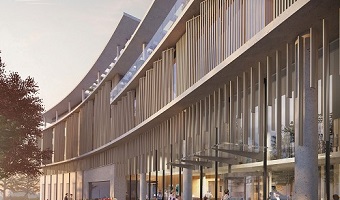It is no secret that the housing sector, particularly in London, has faced turmoil over the past few years. Rising build costs, regulatory confusion, poor sales rates and political and economic risk have all played a part in a slow down of build out rates and housing delivery. Investor appetite in the sector, however, is still present and thriving with investors repositioning assets and de-risking exposure from Open Market Sale homes.
LSH’s UK Investment Transactions Bulletin (‘Living to the Max’) reported that 2024 was a record year for living sector investment, with £18.3bn transacted nationally, including £5.1bn into the Build to Rent (BTR) segment. Institutional investors have partly been attracted to BTR as a result of an acute supply/demand imbalance across the wider Private Rental Sector (PRS) and some have been looking to diversify portfolios.
Tax and regulatory changes have pushed smaller private landlords out of the sector, while high interest rates have forced potential home buyers to rent for longer, driving significant rental growth in recent years.
Despite some high levels of investment, London’s affordability crisis is in full swing. In research published by London Councils, Londoners say they spend 42% of their personal monthly income on their rent or mortgage. With saving for a deposit for home ownership being extremely difficult for many younger (and increasingly older) inhabitants of the Capital, renters are searching hard for good quality, affordable rental homes in central urban locations.
One area of the BTR sub-sector is “co-living” and the LSH Research, Planning Consultancy and Living & Capital Markets teams have been monitoring the notable uptick in investment opportunities in this area.
|
Date |
Property |
Buyer |
Seller |
Deal Type |
Price / Value |
Beds |
|
Q2 2023 |
The Rex, Kingston |
NTT UD Europe |
Amro Partners |
Forward funding |
£80m (GDV) |
210 |
|
Q1 2024 |
Yardhouse, White City |
CDL |
HUB / Bridges |
Forward funding |
£88m |
209 |
|
Q3 2024 |
Brent Cross Town |
DTZ Investors |
Halcyon |
Forward funding |
£100m (GDV) |
300+ |
|
Q4 2024 |
Brixton Junction, Brixton |
Realstar Group |
Node Living |
Stabilised assets |
c. £20m |
63 |
|
Q4 2024 |
Elephant Park, Elephant & Castle |
HUB / HIG |
Lendlease |
Development site (mixed-use/co-living) |
£42m |
N/A |
The Surge in Co-Living
“Co-living” is still a relatively new housing concept in the UK, with the country’s first purpose-built co-living schemes being less than a decade old. However, due to the aforementioned factors, the sector is now growing at an accelerated pace and set to form an increasingly significant part of the overall BTR market as it becomes a more tested solution to the delivery of good quality, affordable urban homes.
At present, there are approximately 8,425 beds in large-scale purpose-built co-living schemes across the UK, representing just 7% of the UK’s total BTR stock. However, the sector is poised for rapid expansion with a further 16,534 beds in schemes either under construction or with planning approved, and an additional 9,694 proposed beds at earlier stages of planning. Co-living schemes represent more than 15% of the total BTR development pipeline.
London has been the main focus for co-living development to date, with 5,091 operational beds, or 60% of the total UK stock. Schemes under construction or with planning granted are set to provide London with an additional 8,837 co-living beds.
Among those close to completion is The Rex, Kingston upon Thames (215 beds), which is due for delivery in 2025. Meanwhile, a recent spate of planning approvals has included Cornerstone (174 beds), which is noteworthy as the City of London’s first consented co-living scheme.
Why the appeal?
Co-living residents are typically characterised as young single tenants; primarily recent graduates, early-career professionals and international residents. Reflecting this, co-living operator VervLife reports that the average age of residents across its London portfolio is 28. However, other operator evidence indicates that the tenant profile is diversifying, and becoming older, as the sector becomes a more established option for renters.
The community and social aspects of co-living are among its key attractions. In addition to providing an array of shared spaces, co-living operators will often organise regular events, giving residents opportunities to meet new people. However, co-living also provides flexibility, allowing each tenant to use a mixture of private and shared areas in ways that suits them individually.
All-inclusive rents add to the appeal of co-living schemes, with rents usually including council tax, utility bills, wi-fi, room cleaning, and access to facilities such as gyms and co-working spaces. While this means that co-living rents can appear relatively high at first glance, the total all-in cost of living will usually be lower than in alternative PRS accommodation where these expenses are not covered by rents.
Location is key to the success of co-living schemes. With many residents reliant on public transport, close proximity to transit hubs, shops and other amenities is essential. The prime sites for co-living schemes are those that will provide tenants with opportunities to live in well-connected central areas lacking other affordable rental options.
Co-Living Investment
To date, a lack of cohesive planning policy and the relatively untested nature of the co-living concept have been the main barriers to investment into the sector. However, an increased volume of capital is now being attracted, as co-living becomes a more accepted model for the cost-effective delivery of city centre homes.
Co-living investment reached £250m in 2024, taking volume over the last five years to £1.1bn. Last year’s deals were concentrated in London and included CDL’s forward funding of Yardhouse, White City for £88m; and DTZ Investors’ funding of a £100m scheme at Brent Cross Town.
In addition, Realstar Group acquired Brixton Junction, a 63-bed operational co-living asset, for more than £20m; while HUB and HIG acquired a plot in Lendlease’s Elephant Park masterplan for £42m, for a mixed-use development including co-living homes.
With stabilised assets in short supply, investment activity is likely to be concentrated on funding and development deals in the medium term. The pace of funding deals should accelerate as more development schemes are brought forward; and there are several live opportunities in the market from developers seeking funding partners for consented schemes.
What about planning?
As a relatively new form of housing delivery, much of the first wave of co-living development has been delivered amid an absence of specific planning policy. There are no national-level planning policies relating to co-living development, and it is not referenced within the recently revised National Planning Policy Framework (NPPF).
Large-scale purpose-built co-living schemes are predominately treated as “Sui Generis”, meaning that Nationally Described Space Standards (NDSS) applying to residential (C3) schemes do not apply. Furthermore, conversions to co-living cannot be delivered using Permitted Development Rights.
More detailed local planning policies are gradually emerging around the sector. Most notably:
The London Plan introduced Policy H16 on co-living in 2021, terming it ‘Large-Scale Purpose-Built Shared Living (LSPBSL)’
The Greater London Authority adopted guidance on how to apply this policy in February 2024. The guidance provides a relatively flexible framework for the delivery of co-living schemes. It includes recommended benchmarks for amenity space provision, and states that private units should be between 18–27 sq m.
An inconsistent approach to co-living planning policy is thus emerging across the country.
Developers will need to be aware of the level of support given locally; and to deliver good quality schemes that demonstrate to planning authorities that co-living is an appropriate form of housing delivery.
Will the sector grow?
The co-living pipeline is full of promise and the potential demand for these homes cannot be underestimated. Nonetheless, there will still be significant planning, funding and development challenges to overcome before schemes currently in the pipeline are brought to completion.
The barriers to co-living development should lower as the sector grows and becomes a more established style of city centre living.
Co-living is also increasingly recognised as a viable development option in London, and it is well placed to become a more mainstream proposition in regional cities over the next few years.
Get in touch

Email me direct
To:
REGISTER FOR UPDATES
Get the latest insight, event invites and commercial properties by email







